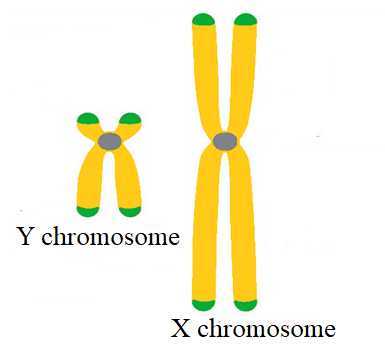
Distinguish between X and Y chromosomes.
Answer
476.1k+ views
Hint: Humans usually have 23 pairs of chromosomes i.e. a total of 46 chromosomes. The autosomes (1-22 chromosome pairs) are the same in males and females. Females have two X chromosomes, whereas males have an X chromosome and a much smaller Y chromosome.
Complete step-by-step answer:
The molecule of a DNA (deoxyribonucleic acid) which contains a part or all of the genetic material of an organism is called Chromosome and pair 23 is dissimilar for males and females.
Difference between the X chromosome and Y chromosome:

Note: Multicellular organisms have special cells called gametes for reproduction which contain only half the number of chromosomes. So when gametes from two different parents combine during reproduction, it results in a new individual, which contains DNA (the genetic material passed from parents) and a re-established number of chromosomes. This process is done by many species to produce their offspring as it is the only means to ensure the continuity of a species.
Complete step-by-step answer:
The molecule of a DNA (deoxyribonucleic acid) which contains a part or all of the genetic material of an organism is called Chromosome and pair 23 is dissimilar for males and females.
Difference between the X chromosome and Y chromosome:
| X chromosome | Y chromosome |
| Appear as X shape as they are metacentric and are longer compared to the Y chromosome. | Appear as Y shape as they are acrocentric and are shorter compared to the X chromosome. |
| It contains a large amount of euchromatin (a lightly packed form of chromatin). | It contains a small amount of euchromatin. |
| It contains a small amount of heterochromatin (condensed chromatin structure). | It contains a large amount of heterochromatin. |
| There is a large amount of DNA or active genes present in the X chromosome. | There is a small amount of DNA or active genes present in the Y chromosome. |
| The X chromosome contains over 1000 genes | The Y chromosome contains nearly 78 genes. |
| Genes present in the X chromosome shows criss cross inheritance. | Genes present in the Y chromosome shows linear inheritance. |
| X chromosomes are found in both genders. | Y chromosomes are found only in males. |

Note: Multicellular organisms have special cells called gametes for reproduction which contain only half the number of chromosomes. So when gametes from two different parents combine during reproduction, it results in a new individual, which contains DNA (the genetic material passed from parents) and a re-established number of chromosomes. This process is done by many species to produce their offspring as it is the only means to ensure the continuity of a species.
Recently Updated Pages
Master Class 11 Accountancy: Engaging Questions & Answers for Success

Express the following as a fraction and simplify a class 7 maths CBSE

The length and width of a rectangle are in ratio of class 7 maths CBSE

The ratio of the income to the expenditure of a family class 7 maths CBSE

How do you write 025 million in scientific notatio class 7 maths CBSE

How do you convert 295 meters per second to kilometers class 7 maths CBSE

Trending doubts
10 examples of friction in our daily life

One Metric ton is equal to kg A 10000 B 1000 C 100 class 11 physics CBSE

Difference Between Prokaryotic Cells and Eukaryotic Cells

State and prove Bernoullis theorem class 11 physics CBSE

What organs are located on the left side of your body class 11 biology CBSE

Write down 5 differences between Ntype and Ptype s class 11 physics CBSE




